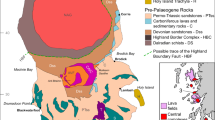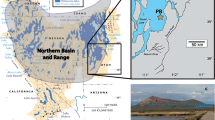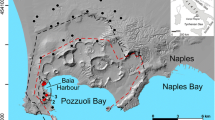Abstract
Diverse subsidence geometries and collapse processes for ash-flow calderas are inferred to reflect varying sizes, roof geometries, and depths of the source magma chambers, in combination with prior volcanic and regional tectonic influences. Based largely on a review of features at eroded pre-Quaternary calderas, a continuum of geometries and subsidence styles is inferred to exist, in both island-arc and continental settings, between small funnel calderas and larger plate (piston) subsidences bounded by arcuate faults. Within most ring-fault calderas, the subsided block is variably disrupted, due to differential movement during ash-flow eruptions and postcollapse magmatism, but highly chaotic piecemeal subsidence appears to be uncommon for large-diameter calderas. Small-scale downsag structures and accompanying extensional fractures develop along margins of most calderas during early stages of subsidence, but downsag is dominant only at calderas that have not subsided deeply. Calderas that are loci for multicyclic ash-flow eruption and subsidence cycles have the most complex internal structures. Large calderas have flared inner topographic walls due to landsliding of unstable slopes, and the resulting slide debris can constitute large proportions of caldera fill. Because the slide debris is concentrated near caldera walls, models from geophysical data can suggest a funnel geometry, even for large plate-subsidence calderas bounded by ring faults. Simple geometric models indicate that many large calderas have subsided 3–5 km, greater than the depth of most naturally exposed sections of intracaldera deposits. Many ring-fault plate-subsidence calderas and intrusive ring complexes have been recognized in the western U.S., Japan, and elsewhere, but no well-documented examples of exposed eroded calderas have large-scale funnel geometry or chaotically disrupted caldera floors. Reported ignimbrite "shields" in the central Andes, where large-volume ash-flows are inferred to have erupted without caldera collapse, seem alternatively interpretable as more conventional calderas that were filled to overflow by younger lavas and tuffs. Some exposed subcaldera intrusions provide insights concerning subsidence processes, but such intrusions may continue to evolve in volume, roof geometry, depth, and composition after formation of associated calderas.
Similar content being viewed by others
Author information
Authors and Affiliations
Additional information
Received: 13 February 1997 / Accepted: 9 August 1997
Rights and permissions
About this article
Cite this article
Lipman, P. Subsidence of ash-flow calderas: relation to caldera size and magma-chamber geometry. Bull Volcanol 59, 198–218 (1997). https://doi.org/10.1007/s004450050186
Issue Date:
DOI: https://doi.org/10.1007/s004450050186




